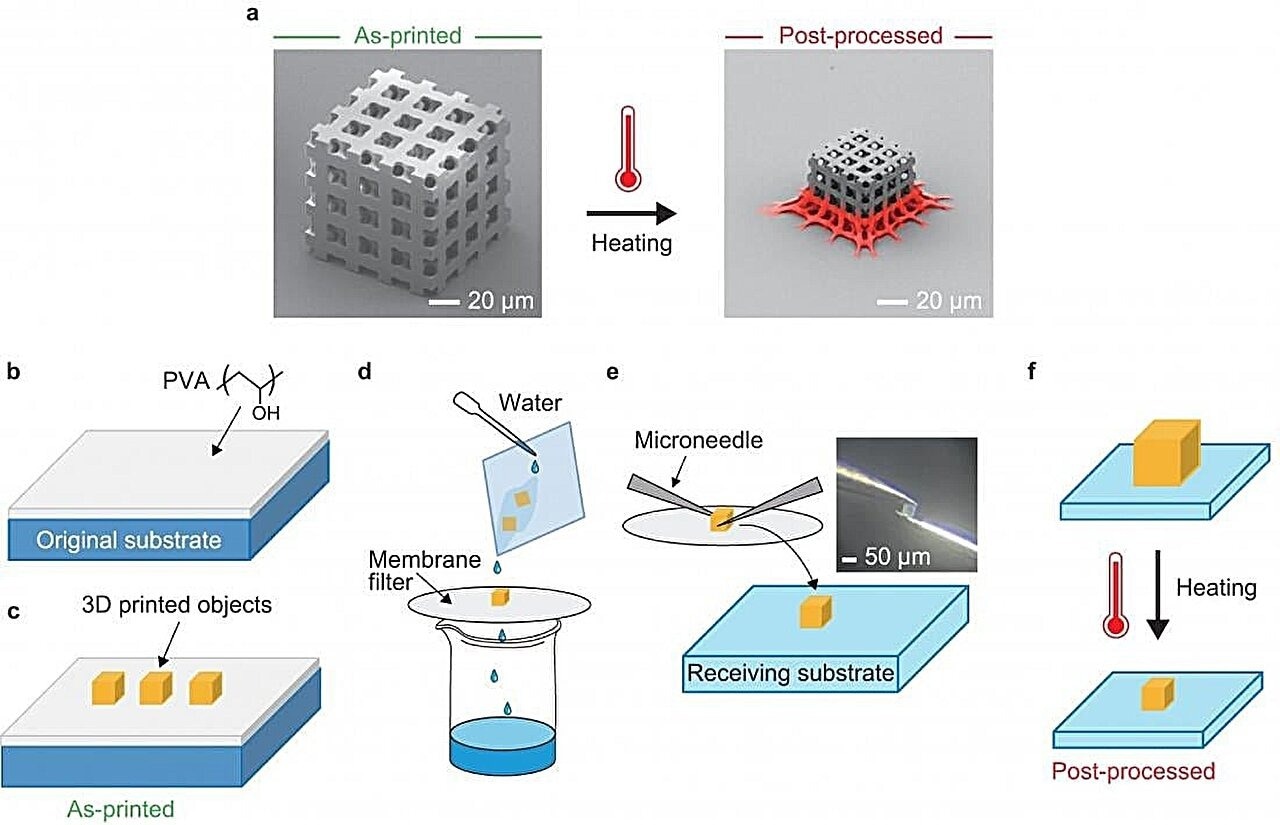3D printing is transforming the production of intricate structures on a large scale, impacting everything from residences to hearing aids.
 Concept and schematic of the pick and place process for uniform shrinking of 3D printed micro-nano structure. Image Credit: Singapore University of Technology and Design
Concept and schematic of the pick and place process for uniform shrinking of 3D printed micro-nano structure. Image Credit: Singapore University of Technology and Design
At micro and nanoscales, two-photon polymerization lithography (TPL) enables the meticulous construction of objects. This process holds extensive implications across industries, from medicine to manufacturing, due to its ability to achieve microscopic precision in creations.
TPL exhibits promising applications in computing and communication by facilitating the creation of innovative optical materials like photonic crystals capable of manipulating light differently.
Nonetheless, realizing its full potential faces hurdles, primarily centered on achieving uniform shrinkage and feature sizes smaller than the wavelength of visible light. This precise control is critical for advanced light manipulation and remains a significant challenge to overcome.
To tackle this obstacle, Professor Joel Yang, leading a team from the Engineering Product Development pillar at the Singapore University of Technology and Design (SUTD), collaborated with experts from the Industrial Technology Center of Wakayama Prefecture in Japan.
Together, they devised a novel technique aimed at achieving uniform shrinkage in 3D-printed structures during heat treatment. This method represents a significant advancement in enhancing the application of TPL for producing exceptionally precise nanoscale features.
The research was published in Nature Communications.
The scientists employed a layer of poly (vinyl alcohol), or PVA, on the printing substrate to assist in washing off 3D-printed parts and moving them onto a separate substrate, thus enabling controlled and uniform reduction of 3D-printed parts. The loose attachment onto the new substrate allows the base of the structures to slide as the overall 3D print to uniformly shrink while heating.
The issue of non-uniform shrinkage caused by the attachment of the structure to the surface on which it was printed is addressed by the simple and effective approach. The option of transferring microscopic 3D-printed parts to integrate with other devices or onto substrates suitable for TPL is unlocked.
Just as earthworms stretch and contract to move across surfaces, we believed we could enable our 3D structures to ‘glide’ to a smaller size without distortion.
Joel K. W. Yang, Author, Engineering Product Development, Singapore University of Technology and Design
Yang drew inspiration from nature to develop this innovative technique.
The complex geometry of the Wakayama prefecture’s mascot - with its various curves, bumps, and dips - made it an ideal subject to showcase our technique’s effectiveness. Successful uniform shrinkage of such a detailed model suggests that our method could be adapted for any form, irrespective of its shape or the solidity of the platform it's placed on.
Tomohiro Mori, First Author and Visiting Researcher, Industrial Technology Center of Wakayama Prefecture
Their method allows for the fabrication of intricately detailed structures that exceed the inherent limitations of their printing equipment. This breakthrough surpasses prior constraints related to resolution and material rigidity commonly associated with 3D-printed objects.
Utilizing this shrinking technique, the researchers can enhance the features of 3D-printed structures to perform novel functions, such as serving as visual indicators by exhibiting structural colors. Crucially, these colors originate from the material's internal structure rather than dyes. As the structure diminishes in size, its interaction with light undergoes alterations that modify its visual appearance.
This presents different functions to materials.
For example, incorporating certain molecules called chromophores, which are sensitive to different types of light, into the structures, could allow us to engineer materials that change colors in response to specific lighting conditions. This has practical applications in anti-counterfeiting, where items can be verified as genuine through distinct structural colors and the emission properties of these materials.
Joel K. W. Yang, Author, Engineering Product Development, Singapore University of Technology and Design
The method established by the researchers finds application in industries like electronics, which can be utilized to produce complicated heat sinks required for cooling high-performance devices like state-of-the-art GPUs and CPUs.
The consistent reduction of printed components also enables applications in fields that require high fidelity in material structuring, such as mechanical parts with complex geometries, optical elements with precise light manipulation capabilities, and acoustic devices that can govern sound with high accuracy.
Looking forward, the scientists plan to expand the applications of their method beyond the current polymeric resin material used in research. The scientists aim to produce more effective photonic crystals, which could improve the methodologies in lasers, imaging systems, and optical sensors by applying their method to materials with higher refractive indices.
In addition, the team is also refining the control of spacing in printed structures to produce full-color, 3D models that can precisely control the way light is manipulated.
Their endeavors encompass transferring and precisely situating these structures across expansive areas or in substantial quantities, all while upholding the exacting precision demanded by these advanced applications.
Journal Reference:
Mori, T., et al. (2023). Pick and place process for uniform shrinking of 3D printed micro- and nano-architected materials. Nature Communications. doi/s41467-023-41535-9